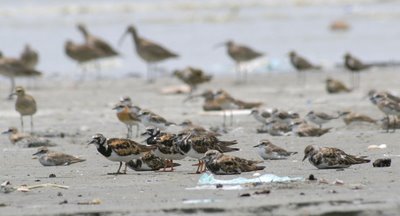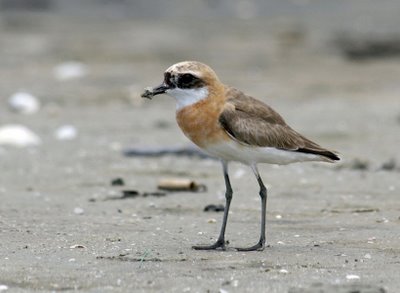I found that the mud at this site is quite firm, enabling me to walk out some way. So I found a couple of wooden pallets from the tideline debris, dragged them out onto the mud, lay down on my front and covered myself with a piece of gunny sacking that I carry in the car for just such an occasion.
Lying under the midday sun on the mud in this humidity was somewhat similar to sitting in a sauna with all my clothes on, but this was more than made up for by the fact that the birds quickly accepted this new piece of litter in their territory, and soon I was being treated to amazingly close views by some of the feeding plovers and stints.
Some distance away, the main flock consisted of many birds still in the remains of their breeding plumage - gorgeous orange-bibbed Lesser Sand Plovers, smart black, white and chestnut Ruddy Turnstones, and one or two Pacific Golden Plovers still with their black underparts.

The two Greater Sand Plovers (in non-breeding plumage) stand head and shoulders above the Lessers in this flock.

The duller Ruddy Turnstones on the right are probably females.

The all-black forehead of the breeding plumage Lesser Sand Plovers is diagnostic of the race 'schaeferi', which is the longest-billed of all the races of Lesser. It apparently breeds from Southern Tibet to Mongolia and is probably the commonest race that occurs here in the northern winter.

One of the most confiding birds was a juvenile Lesser Sand Plover, which set up a feeding territory just in front of me, enabling me to get wonderful views.
No comments:
Post a Comment